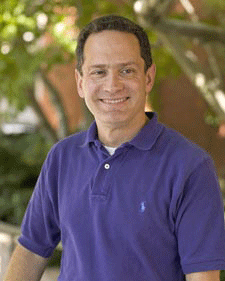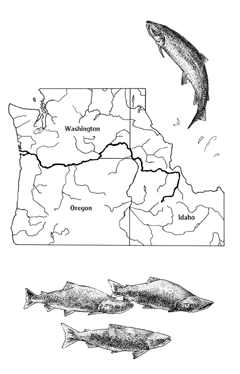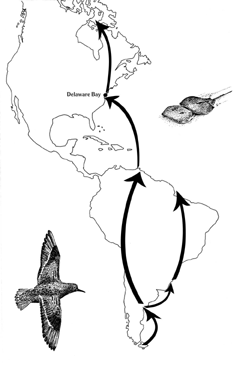Not So Great Migrations
Air Date: Week of November 16, 2007

Professor David Wilcove with a rhinoceros. (Photo: Nathan Gregory)
The world's great animal migrations are in trouble. Whales, birds, and even insects are finding it harder to make routine journeys necessary to their survival, says ecologist David Wilcove. Host Steve Curwood talks to Wilcove about his book, "No Way Home," on the challenges migratory animals face and the challenges scientist face in tracking them.
Transcript
[SOUNDS OF A TENNESSEE WARBLER WARBLING]
CURWOOD: That’s a Tennessee warbler—a song of summer now silent in America’s woodlands as birds head south for warmer weather and food. But the huge flocks of thrushes and swallows and warblers that used to crowd the skies are thinning as they and many other creatures are now finding it difficult to complete their migrations.
Joining me now is David Wilcove, Professor of Ecology and Evolutionary Biology at Princeton University. He’s written a new book called “No Way Home: The Decline of the World’s Great Animal Migrations.” Hello, Professor.
WILCOVE: Hello.
CURWOOD: Tell me, why is migration so important?
WILCOVE: It’s important for a variety of reasons. It’s an absolutely magical thing to see. It inspires like few other phenomena in nature. But it’s also important ecologically because the movements of these animals over great distances provide a range of benefits to humanity. Birds migrating through the forests eat insects that would otherwise harm the trees; salmon migrating upstream and dying basically transport nutrients from the oceans to the rivers; and monarch butterflies moving south in the fall are basically pollinating plants as they go along.
CURWOOD: So, the forest needs the fish?

Professor David S. Wilcove of Princeton University(Photo: (c) Jon Roemer/Woodrow Wilson School)
CURWOOD: Into the grapevine and then into the wine that you and I get to drink.
WILCOVE: That’s right. So some of the wine might have a slightly salmony taste.
CURWOOD: What is it that attracted you to study migrations, David Wilcove?

Salmon travel from Idaho streams to the Pacific Ocean. (Photo: Louise Zemaitis)
CURWOOD: Tell me about some of the challenges that some of these migratory species face.
WILCOVE: Migratory species have to get from one location to another often at great distance, and they have to contend with a loss of habitat on their breeding grounds, on their wintering grounds, and on the areas where they stop and rest in between. They have to contend with disease, with climate change, and they also run the risk of being harvested by humans because they often aggregate in large numbers, like a herd of bison or salmon moving upriver. All of these threats have driven many migratory species way down in numbers.
CURWOOD: So, tell me about the most arduous journeys that creatures make to migrate.
WILCOVE: On land, there’s a population of prong-horned antelope that migrates from Grand Teton Park in Wyoming down to the Wind River Range and they have to cross 300 miles of land that is now riddled with fences, oil and gas developments, suburban housing developments, and as a result, there are only a couple hundred prong-horned antelope left that are able to make the journey. We have salmon in the Northwest that migrate over 900 miles upstream, and they have to contend with major power damns, with logging operations that damage the streams.

The red knot's epic migration - from pole to pole.(Photo: Louise Zemaitis)
CURWOOD: So, I noticed in your book you write about dragonflies and a device to track a dragonfly. Tell me more about this device. I mean, a dragonfly doesn’t weigh that much. I mean, what exactly was the technology that was used to put a tracking device on these dragonflies?
WILCOVE: I was in Cape May, New Jersey with my colleague Martin Wikelski, and he has pioneered the study of migratory birds by putting very small transmitters on them. And we were looking at the migration of dragonflies in Cape May. Millions of dragonflies migrate through Cape May. And I said ‘do you think we could find a transmitter small enough to fit on a dragonfly?’ And he said he though the people he worked with could come up with something. And, sure enough they did. They developed a tiny radio transmitter weighing about one 100th of an ounce that we could glue onto the belly of a dragonfly, release the dragonfly, and then follow it in a light airplane as the dragonfly migrated south. And we tracked individual dragonflies going 80 to 100 miles in a day.

Professor David Wilcove with a rhinoceros. (Photo: Nathan Gregory)
CURWOOD: At the end of the day, what can really be done to protect migratory species?
WILCOVE: The challenge in protecting migratory species is twofold. You’ve got to get different states, agencies, nations, to cooperate, to work together. And you have to protect the species while they’re still common because that’s part of the glory of migration—the sheer abundance of the animals. So the core challenge is getting different jurisdictions to cooperate, to plan together, and it’s getting people concerned about these species before they become endangered. Because once they’re endangered, for all intents and purposes, the glory of the migration has been lost.
CURWOOD: So, what can I do as an individual?
WILCOVE: As an individual, you can of course, play an active role in land use decisions in your community and in the country as a whole. That is to say you can protect open space and parks, which will be important for migratory species. You can be an educated consumer to make sure that the seafood you purchase did not come at the expense of sea turtles, which are often drowned in commercial fishing operations. And of course, you can advocate greater assistance to other countries for their conservation because after all, every acre of forest that we protect, in Mexico, or in Central America, is likely to be an acre of forest that provides songbirds for us in the United States in the spring.
CURWOOD: Ecologist and Princeton University professor David Wilcove’s new book is called “No Way Home.” Thank you so much, Professor Wilcove.
WILCOVE: It’s been a pleasure.
Links
"No Way Home" from Island Press
David Wilcove at Princeton University's Department of Ecology and Evolutionary Biology
Living on Earth wants to hear from you!
Living on Earth
62 Calef Highway, Suite 212
Lee, NH 03861
Telephone: 617-287-4121
E-mail: comments@loe.org
Newsletter [Click here]
Donate to Living on Earth!
Living on Earth is an independent media program and relies entirely on contributions from listeners and institutions supporting public service. Please donate now to preserve an independent environmental voice.
NewsletterLiving on Earth offers a weekly delivery of the show's rundown to your mailbox. Sign up for our newsletter today!
 Sailors For The Sea: Be the change you want to sea.
Sailors For The Sea: Be the change you want to sea.
 The Grantham Foundation for the Protection of the Environment: Committed to protecting and improving the health of the global environment.
The Grantham Foundation for the Protection of the Environment: Committed to protecting and improving the health of the global environment.
 Contribute to Living on Earth and receive, as our gift to you, an archival print of one of Mark Seth Lender's extraordinary wildlife photographs. Follow the link to see Mark's current collection of photographs.
Contribute to Living on Earth and receive, as our gift to you, an archival print of one of Mark Seth Lender's extraordinary wildlife photographs. Follow the link to see Mark's current collection of photographs.
 Buy a signed copy of Mark Seth Lender's book Smeagull the Seagull & support Living on Earth
Buy a signed copy of Mark Seth Lender's book Smeagull the Seagull & support Living on Earth

